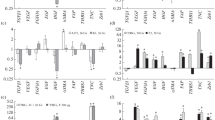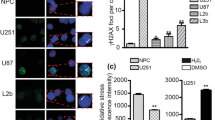Abstract
We investigated the production of interleukin 6 (IL-6) by a radioresistant human glioblastoma cell line G5 after single radiation events of 3, 6 and 9 Gy. The total cell number and IL-6 concentration in culture supernatant were assessed 24–96 h after irradiation. The radiation impeded or stopped G5 cell growth in a dose-dependent manner, but unexpectedly did not affect the IL-6 concentration in cell culture media that increased in the same range as in non-irradiated cultures. Furthermore, using flow cytometry, we found that the IL-6 positive cells expansion was unaffected by radiation. These findings suggested that this small (about 1%) fraction of G5 cells, constitutively producing IL-6, is highly radioresistant.
Similar content being viewed by others
References
Mornex F, Nayel H, Taillandier L: Radiation therapy for malignant astrocytomas in adults. Radiother Oncol 27: 181-191, 1993
Van Meir E, Sawamura Y, Diserens A-C, Hamou M-F, de Tribolet N: Human glioblastoma cells release interleukin 6 in vivo and in vitro. Cancer Res 50: 6683-6688, 1990
Huettner C, Paulus W, Roggendorf W: Messenger RNA expression of the immunosuppressive cytokine IL-10 in human gliomas. Am J Pathol 146: 317-322, 1995
Giometto B, Bozza F, Faresin F, Alessio L, Mingrino S, Tavolato B: Immune infiltrates and cytokines in gliomas. Acta Neurochir (Wien) 138: 50-56, 1996
Goswami S, Gupta A, Sharma SK: Interleukin-6-mediated autocrine growth promotion in human glioblastoma multiforme cell line U87MG. J Neurochem 71: 1837-1845, 1998
Rolhion C, Penault-Llorca F, Kemeny J-L, Lemaire J-J, Jullien C, Labit-Bouvier C, Finat-Duclos F, Verrelle P: Interleukin-6 overexpression as a marker of malignancy in human glioma. J Neurosurg 94: 97-101, 2001
Lanza L, Scudeletti M, Meazza R, Ferrini S, Indivieri F, Jasmin C, Azzarone B: Induction of apoptosis in human melanoma cell lines by taxol and IL-6 antisens oligonucleotides (Abstract). Am Ass Cancer Res Proc 40: 487, 1999
Lu C, Sheehan C, Rak JW, Chambers CA, Hozumi N, Kerbel RS: Endogenous interleukin 6 can function as an in vivo growth-stimulatory factor for advanced-stage human melanoma cells. Clin Cancer Res 2: 1417-1425, 1996
Borsellino N, Belldegrun A, Bonavida B: Endogenous interleukin 6 is a resistance factor for cisdiamminedichloroplatinum and etoposide-mediated cytotoxicity of human prostate carcinoma cell lines. Cancer Res 55: 4633-4639, 1995
Borsellino N, Bonavida B, Ciliberto G, Tonatti C, Travali S, D'Alessandro N: Blocking signaling through the Gp130 receptor chain by interleukin-6 and oncostatin M inhibits PC-3 cell growth and sensitizes the tumor cells to etoposide and cisplatin-mediated cytotoxicity. Cancer 85: 134-144, 1999
Chung TD, Yu JJ, Spiotto MT, Bartkowski M, Simons JW: Characterization of the role of IL-6 in the progression of prostate cancer. Prostate 38: 199-207, 1999
Mitzutani Y, Bonavida B, Koishihara Y, Akamatsu KI, Ohsugi Y, Yoshida O: Sensitization of human renal cell carcinoma cells to cis-diamminedichloroplatiunm (II) by anti-interleukin 6 monoclonal antibody or anti-interleukin 6 receptor monoclonal antibody. Cancer Res 55: 590-596, 1995
Yonish-Rouach E, Resnitzky D, Lotem J, Sachs L, Kimchi A, Oren M: Wild-type p53 induces apoptosis of myeloid leukeamic cells that is inhibited by interleukin-6. Nature 352: 345-347, 1991
Sachs L, Lotem J: Control of programmed cell death in normal and leukemic cells: new implications for therapy. Blood 82: 15-21, 1993
Puthier D, Derenne S, Barille S, Moreau P, Harousseau JL, Bataille R, Amiot M: Mcl-1 and Bcl-xL are co-regulated by IL-6 in human myeloma cells. Br J Haematol 107: 392-395, 1999
Neta R, Perlstein R, Vogel SN, Ledney GD, Abrams J: Role of interleukin 6 (IL-6) protection from lethal irradiation and in endocrine responses to IL-1 and tumor necrosis factor. J Exp Med 175: 689-694, 1992
Miwa H, Kanno H, Munakata S, Akano Y, Taniwaki M, Aozasa K: Induction of chromosomal aberrations and growth-transformation of lymphoblastoid cell lines by inhibition of reactive oxygen species induced apoptosis with interleukin 6. Lab Invest 80: 725-734, 2000
Yamanaka R, Tanaka R, Yoshida S: Effects of irradiation on cytokine production in glioma cell lines. Neurol Med Chir 33: 744-748, 1993
Ross HJ, Canada AL, Antoniono RJ, Redpath JL: High and low dose rate irradiation have opposing effects on cytokine gene expression in human glioblastoma cell lines. Eur J Cancer 33: 144-152, 1997
Buronfosse A, Thomas CP, Ginestet C, Doré JF: Radiosensitivity in vitro of clonogenic and non-clonogenic glioblastoma cells obtained from a human brain tumor. CR Acad Sci Paris, Sciences de la vie/Life sciences 317: 1031-1047, 1994
Lu C, Kerbel RS: Interleukin-6 undergoes transition from paracrine growth inhibitor to autocrine stimulator during human melanoma progression. J Cell Biol 120: 1281-1288, 1993
Author information
Authors and Affiliations
Rights and permissions
About this article
Cite this article
Dubost, JJ., Rolhion, C., Tchirkov, A. et al. Interleukin-6-producing Cells in a Human Glioblastoma Cell Line are not Affected by Ionizing Radiation. J Neurooncol 56, 29–34 (2002). https://doi.org/10.1023/A:1014467804488
Issue Date:
DOI: https://doi.org/10.1023/A:1014467804488




